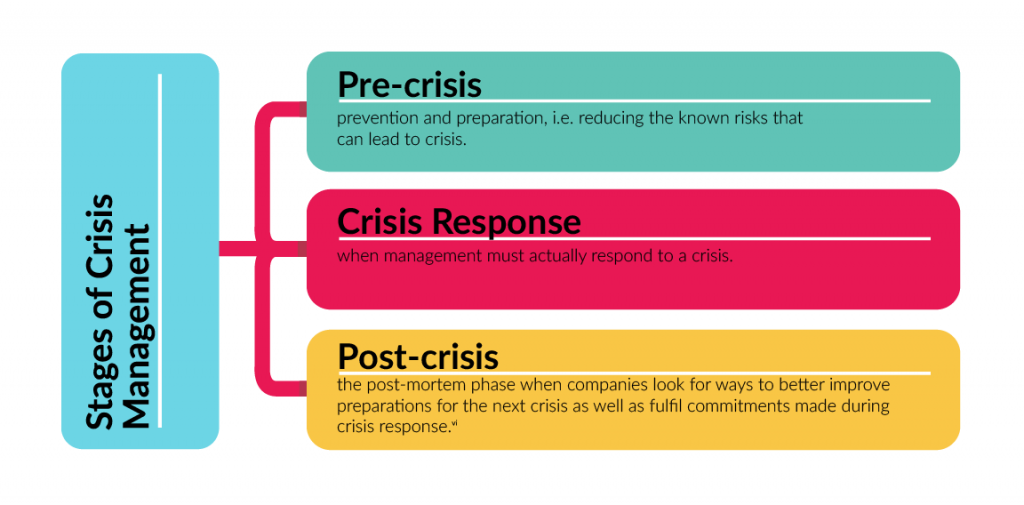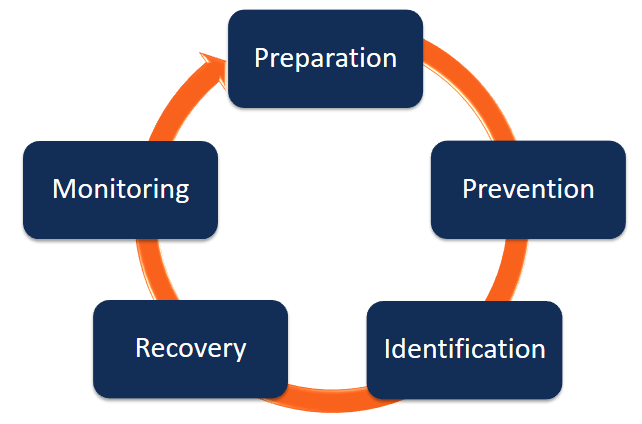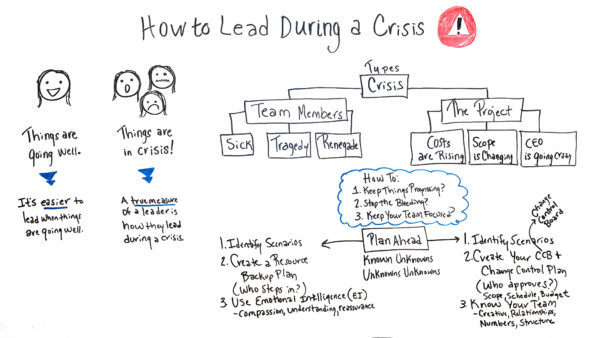A s your company grows, so do the potential risks. Crises can impact any business, regardless of size or industry. From global issues like the COVID-19 pandemic to unexpected technological or operational challenges, crisis management planning becomes essential for business continuity.
It’s not usually something you’re prepared for, but once it happens, you sure do wish you were.
In this guide, we’ll break down the steps to create a crisis management plan (CMP) that ensures your business continues operating during a crisis, while minimizing impact on employees, reputation, and finances.
- What Is A Crisis and Why plan for One?
- Crisis Stages
- How to Create a Crisis Management Plan: Step by Step
- Why Should You Have a Crisis Management Plan?
- Crisis Management Tips
This will help you execute the appropriate steps to reduce the negative effects of the crisis. With the proper crisis response strategies, your company can counter any misinformation and head in the right direction.
What is a crisis and why plan for one?
Before we lay out the steps for a crisis management plan, we have to understand what a crisis is.
A crisis is any unexpected event that can disrupt your business operations or harm your corporate brand. It could be internal, like a PR disaster or data breach, or external, like a natural disaster.
Ignoring potential crises is a gamble most businesses can’t afford. Being prepared with a solid crisis response plan means you can handle crisis situations as they unfold, without panic.
A crisis inside business is an event that has the potential to negatively affect the company, by negatively impacting its employees, finances or reputation.
A crisis can be caused by internal factors (such as employees making certain public statements or not doing their job properly) or external factors (such as natural disasters).
One of the most common issues is that entrepreneurs, CEOs, directors and managers often think that such events won’t happen to them.
“My employees would never do such a thing.”
or
“That’s never going to happen to us.”
But that’s not the case at all. It will never happen to you until it does! If you are here before any crisis ever hit your business, congratulations. If you’re here as the crisis unfolds… better late than never. Keep reading and you’ll find out everything you need to know. We’re sure you’ll pull this through!
Surely, the possibilities for a crisis are endless in all cases, regardless of the type of company you’re running. But some apply better to certain types than others.
For example, if you own a pharmaceutical company, a possible scenario is that a new product you’ve released is having severe negative effects on the customers and it’s made the news.
In crisis management, be quick with the facts and slow with the blame.
Leonard Saffir, Public relations executive
In all cases, your company might suffer from how the media covers the situation, so make sure that you keep in close touch with your PR team, for the best damage control.
Crisis stages
The crisis management process can be categorised in 3 main stages, the pre-crisis, the management and response stage itself and the post-crisis.
According to Everbridge, a crisis unfolds itself in 6 stages. In a real case scenario, you won’t be able to go through all these stages without a crisis management plan in place.

Warning stage
First you have the warning phase. The crisis did not happen yet, but there are warning signs about it. For example, you might hear at the news that a hurricane is about to strike.
Acting as soon as possible can help you greatly reduce the damage produced by the crisis.
Unfortunately, you can’t always predict when a crisis will happen, but there are almost always signs that it will, whether they are in the company’s financial records or in past or recent employee behaviour.
Risk assessment stage
The risk assessment stage begins once the crisis starts to unfold. This is when you’ll sit down with your team to analyse what exactly is happening, what are the risks and estimate the damage and how the crisis will impact the business, it’s employees and it’s customers.
This stage involves a lot of communication with your team.
Response stage
Once the risks have been assessed, it’s time to decide which plan to implement. Once everyone has been notified about the decision, you start putting the plan in action. This stage involves open communication with your team so it’s a good idea to have a detailed business communications strategy.
Management stage
This is the stage in which you actually execute the plan, with the intent to reduce immediate effects of the crisis and possible future issues that may arise.
This stage also involves a lot of communication to ensure that everyone is on the same page, from employees, to stakeholders and, ultimately, clients.
Resolution stage
At this stage, everyone has fulfilled their duty and hopefully, the crisis is over or nearly over and everything is under control. It’s at this point when you’ll start to discuss how to recover from the crisis.
If you’ve planned well ahead, you’ll know exactly what steps to take.
Recovery stage
Finally, once the crisis has passed, your recovery plans are already in action and everything starts to get better and hopefully back to normal. Employees return to their daily activities, sales start to go up again and finances start to recover.
They are talking about your company
Get instant access to brand mentions across social, news, blogs, videos and more. Get Free Report
How to create a crisis management plan: Step by Step
Here’s how to lay out a business crisis management plan in 6 easy steps. Each step might include multiple substeps which you have to take care of, depending on the size and type of your company.

1. Identify possible types of crises and their impact
First, make sure you can clearly differentiate between a crisis and something that isn’t a crisis.
You’ll need to be able to clearly define what a crisis means for you.
You can have incidents (which are often single occurring events which unfold in a short amount of time), you can have emergency situations (which might be more stressful but won’t heavily impact the business’s finances or reputation) and finally, you can have a critical situation which will heavily impact your business.
There are many types of crises that can affect your business. Some might fit more to your type of business than others. In your general crisis management plan, you should lay out multiple plans for your business, to consider all possible crisis scenarios.
Understanding the possible types of crises is essential for effective crisis response. Some common crises include:
- Natural disasters (earthquakes, hurricanes, pandemics)
- Technological issues (cyber-attacks, data breaches)
- Financial loss (sudden economic shifts)
Each type of crisis requires different response plans, so it’s critical to conduct a business impact analysis and understand how each could affect your critical business functions.
In cases of severe emergencies, businesses may need to contact sales teams or other key elements of the organization to ensure that action plans are followed correctly. When crisis management is taken seriously, it ensures that a business is prepared for any global crisis, from natural disasters to technological failures.
Many of these scenarios can differ from one case to another and often include multiple subcategories. Businesses should use crisis management plan examples and plan templates to ensure their response is effective. Senior executives must be actively involved in project planning and work closely with the crisis response team to minimize risks. Clear management and communication protocols, like those in United Airlines' case, are essential for mitigating damage.
For example, human error or malpractice issues can be related to personnel or be organisational. In either case, having clear crisis management plan examples helps companies stay prepared. Whether it’s emergency management during a crisis occurring or creating emergency response protocols, having a structured crisis management plan template can make all the difference.
In the first case, an employee causes the issues which lead to negative consequences (such as forgetting to uncover a sensor after cleaning an airplane, leading to a plane crash), and in the second case, management is responsible for the consequences (for example, requests by employees to replace damaged or old equipment are ignored, resulting in the crash). This highlights the importance of crisis management and why management practices need to be strict and efficient.
Other crises might happen solely online. Media outlets and social media are very powerful tools these days, both for promoting a company or defaming one.
The trigger can be something as insignificant as an employee, manager, or shareholder tweeting something controversial.
A great example is how United Airlines faced a global crisis after a viral video damaged its reputation.
Surely this can be classified as “professional negligence,” but it wouldn’t be completely fair to call it that. This is also pretty hard to prevent, as in the US, at least, it’s difficult to tell people what they can and can not say, as far as the First Amendment dictates.
In a crisis, don’t hide behind anything or anybody. They’re going to find you anyway.
Bear Bryant, former Alabama football coach
Crisis planning should focus on identifying potential risks, creating action plans, and having an activation protocol in place. Proper management and communication ensure these steps are followed.
That’s why monitoring your brand’s mentions and managing your reputation are so important. They can warn you about online crises that hurt your company way before they happen.
They are talking about your company
Get instant access to brand mentions across social, news, blogs, videos and more. Get Free Report
Once you’ve laid out the possible crisis scenarios, you have to identify their potential impact. How will they affect the business? Which are the areas / sectors that will suffer the most? What financial loss can each crisis ultimately lead to?
Possibilities are endless, so a brainstorming session will be helpful. Once the ideas are laid out, you can start arranging them depending on how likely they are to happen and how hard they will impact the company.
To be able to go through the entire crisis management process, first you have to determine what causes a crisis in each particular case. Again, there could be multiple possibilities, so it’s important to decide which ones are most likely to happen and why.
It’s very important to know when the activation point is. Is this truly a crisis? Are we executing the plan now?
2. Set up roles, teams and communication
Building a crisis response team ensures you have the right people in place to handle emergencies.
It might sound expensive… but would you rather let your company take a major PR hit causing huge loss in profit, or prevent that from ever happening? A major crisis can be far more expensive.
In some cases, you might want to consider working with a professional crisis management team. However, you can also develop your own, internally, which can be even more effective if done properly.
- Crisis Team Leader: Someone with experience in dealing with crises that can help manage the team or train someone to manage the entire team.
- Public Relations Specialist: Someone with experience in dealing with media coverage in stressful circumstances such as a crisis.
- Human Resources Advisor: Someone with experience in managing the staff properly and that can ensure proper communication between the teams.
- Legal Advisor: Depending on the type of crisis you are facing, you might require the help of a legal or financial advisor. They can ensure your actions are not wrong from a legal point of view, or that certain actions won’t affect your finances even more.
- Crisis Communication Plan Manager: Manages both internal and external communication..
These are just some of the top roles, but your teams will end up with a lot more roles than that.

That’s why it’s also a good time to start planning the crisis communications strategy. You’ll need to set up a proper communications channel which will include a very detailed contact list.
Who will contact who? Who will cover the media crisis response? Who is going to be the spokesperson? Who will contact the employees, stakeholders and clients?
3. Develop a communication plan
A crisis communication plan is essential for informing your key stakeholders. Your communication planning should include response procedures for both internal and external communication to keep employees, customers, and partners informed.
Make sure your communication strategy includes a plan template for quick, consistent responses.
In case of natural disaster, for example, you might require an evacuation plan for your employees.
In case of negative PR situations, you might want to focus more on media coverage.
The steps will differ from one case to another. It’s a good idea to follow the ‘if this then that’ methodology. This way you’ll be prepared for many more possibilities.
4. Assign Roles and Responsibilities
Practice makes perfect. Hopefully, you’ll never have to prove your skill. But if you want to be prepared, having a plan isn’t enough.
Clarity in roles and responsibilities helps streamline actions during a crisis. Everyone, from the leadership team to frontline employees, should know their part. Your crisis response team should regularly engage in training sessions to ensure they're ready to implement the crisis management plan effectively.
If you truly want to prepare your business for crises, you’ll have to simulate them to test the plan and how people respond to it.
Users should be familiarized with their roles in a crisis response, from employees and managers to stakeholders. The crisis communications channels should be working flawlessly.
Testing and updating your plan is essential to figure out its effectiveness in a possible real life scenario.
Crisis management should be embedded in a program that the organisation takes seriously such as Quality Control. This will ensure that everyone is aware to some extent that a crisis could happen at any point and that they could help prevent it.
5. Start monitoring
Once you’ve finished everything, it’s time to look out for crises. Don’t get paranoid, but be cautious. The more your company grows, the more partners you engage with, the wider your products spread, the higher the risks for a major crisis to take place are.
Your crisis response planning should cover various scenarios, including:
- Technological issues: Address data breaches or system failures.
- Natural disaster: Plan for evacuations or safety measures.
- PR crises: Develop media management strategies.
By including a command center plan and contingency planning, your team will be able to respond swiftly to any challenge.
Have weekly or monthly reports from different departments and make sure things are under control.
Brand is no longer what we tell the customers it is - it is what consumers tell each other it is.
Scott Cook, director of eBay and Procter & Gamble
Monitoring your brand’s online mentions with a tool like BrandMentions can help you identify when a crisis is about to start, as soon as it happens. This helps you not be taken by surprise and gives you time to execute your plan.
A crisis management plan should be updated regularly based on new risks and challenges. Conduct risk assessments and adjust your management planning accordingly. Remember, an outdated plan is almost as bad as having no plan at all!
Why should you have a crisis management plan?
According to Deloitte, almost half of the companies ignore key steps to prepare for crises. But why should you bother setting up a crisis management plan?
Crisis situations can strike unexpectedly, and the fallout from not being prepared can be catastrophic. An effective crisis management plan offers several benefits:
- Business continuity: Having a business continuity plan (BCP) allows your business operations to continue during disruptions.
- Reduced financial loss: Planning for crises minimizes potential financial loss.
- Building trust: A well-executed crisis response builds trust with external stakeholders, customers, and employees.
Proactive crisis management strategies help maintain your corporate brand during times of turbulence and avoid the significant impacts on your business that could otherwise occur.
First of all, you’ll know exactly what you have to do. If you’re serious about it, you might have even gone through some training and have some experience.
Secondly, prevention is better than treatment. By laying out a plan, you’ll be a lot more responsive to possible crisis triggers.
Last but not least, when a crisis happens, it isn’t generally a single event. They happen in a chain reaction or set off a chain reaction of events.
In case of natural disaster, for example, first you’ll have to deal with the employees and possible casualties, then recover financially. This means a safety plan and a financial recovery one. If the disaster is caused by professional negligence, then you can add negative PR to it, which will impact sales and revenue.
Note that a crisis management plan (CMP) might also be referred to as a business continuity plan (BCP) or even a disaster recovery plan, depending on the type of business and the sector it operates in.
A disaster recovery plan focuses solely on controlling the damage in case of a natural or human caused disaster, while a business continuity plan will focus on maintaining the critical business operations, rather than controlling and minimising damage.
While they overlap in certain areas, they are distinct from one another.
Crisis management tips
On an ending note, below are some tips and reminders.
Don’t do too much introduction or definition. This is for you to understand, fine, have it separately somewhere else. The final plan itself must be like a panic button which you can press and get to work and implement it as soon as possible.
Study other crises from similar companies to identify early warning signs and possible mistakes they’ve made along the route so that you don’t repeat them.
Training is useful. Testing is useful. Updating is useful. Train, test and update your plan for crisis management if you want it to be effective.
Don’t mix everything in a single document that is hard to navigate and takes ages to load. Sure, it’s useful to have a roadmap somewhere, be it a table of contents with links to where each section begins or a navigable mind map with ramifications. But the crisis management plan template for each scenario should be clearly delimited so they are easy to pull out and execute.
Each crisis management strategy should outline the key elements needed for an effective crisis response. For example, in crisis planning, having contingency planning and specific response procedures defined for business functions ensures a smooth workflow. Plans should include risk analysis and identifying potential potential threats that could impact the company.
Last but not least, invest in modern technology. It’s faster, and it will help you resolve a crisis more efficiently. Let’s take a basic example: cybercrime. If your entire company operates on outdated systems like Windows XP in 2022, expect it to be highly vulnerable to cyber-attacks. For companies concerned about unexpected events or security collapses, advanced solutions like rackmount servers can secure content on fast, reliable servers, ensuring the leadership team and management teams can work securely and quickly.
Additionally, crisis management plans should be updated regularly to address new emergency management protocols, ensuring that key stakeholders and external stakeholders are kept informed through well-prepared communication templates. This approach allows your management teams to respond swiftly to any crisis occurring, whether it’s technological, operational, or reputational.

Don’t rush to change things too fast, though. You don’t want any other type of crisis to happen in the middle of a transition, when people don’t know how to properly use the new technology yet.
Having a well-structured command center plan is crucial during a crisis. With a defined command center, clear chain of command, and emergency contacts ready, your business is better equipped for successful crisis management. This plan should also include an activation protocol to notify the right people quickly, ensuring that emergency response procedures are triggered immediately.
Moreover, your risk registers should be updated regularly, and project planning for crisis scenarios should be a part of your broader management practices. High-level senior executives should be involved in crisis management teams to oversee the crisis management plan template and guide the command center during the crisis. Ensuring that media outlets and contact sales teams are informed and aligned with the company's crisis response strategy is another key part of reducing the impacts on your business.
By maintaining contingency planning and performing regular risk analysis, you’ll be able to stay ahead of potential threats and handle crises before they escalate, safeguarding your company’s assets, reputation, and future.
They are talking about your company
Get instant access to brand mentions across social, news, blogs, videos and more. Get Free Report
Crises are inevitable, but effective crisis management can make all the difference in how your business continues to operate. By creating a robust crisis management plan, you can mitigate risks, reduce business impact, and ensure that your company survives and thrives even in challenging times.
Here are some practical tips for successful crisis management:
Train Your Team
Conduct regular training sessions with your crisis teams to ensure everyone understands their roles and responsibilities. Ensure the team knows how to handle the chain of command and execute response plans.
Monitor for Potential Crises
Use tools like risk registers and business impact analysis to monitor for potential threats. Early detection is key for a successful crisis response.
Focus on Communication
During a crisis, effective communication is critical. Ensure your crisis communication plan includes communication templates for immediate responses to stakeholders and media.
Learn from Past Crises
Every crisis is a learning opportunity. After handling a crisis, conduct a post-mortem review to identify areas for improvement and update your crisis management plan as necessary.
Keep Your Plan Up-to-Date
A crisis management plan should never be static. Regular risk analysis, updated emergency contacts, and new crisis scenarios should be integrated as your business grows.
Always remember to update your crisis management plan, test your procedures, and train your team. With the right crisis response planning and management strategies, you’ll be well-prepared for whatever challenges come your way.
Effective crisis management requires proactive planning, strategic resource allocation, and a commitment to lessons learned from past events. A successful crisis management plan should be a living document, continuously updated through tabletop exercises to prepare for critical events such as technology failures or a corporate crisis. Organizations must focus on identifying potential risks and implementing crisis communication strategies with clear communication protocols to ensure a swift and effective response action. Utilizing board management software can enhance board management coordination, while mass notification systems help disseminate urgent information. Avoiding a poor crisis response means having a complete crisis management approach that includes critical event management and secure access, such as a client login, to relevant crisis materials. By prioritizing preparedness, companies can minimize the impact of crises and ensure a well-coordinated, resilient response.
Hopefully, this will help you properly develop a crisis management plan. Ultimately, you might want to seek professional help from an experienced advisor such as Mr. Ian Mitroff or an entire company that deals with crisis management such as Deloitte.

